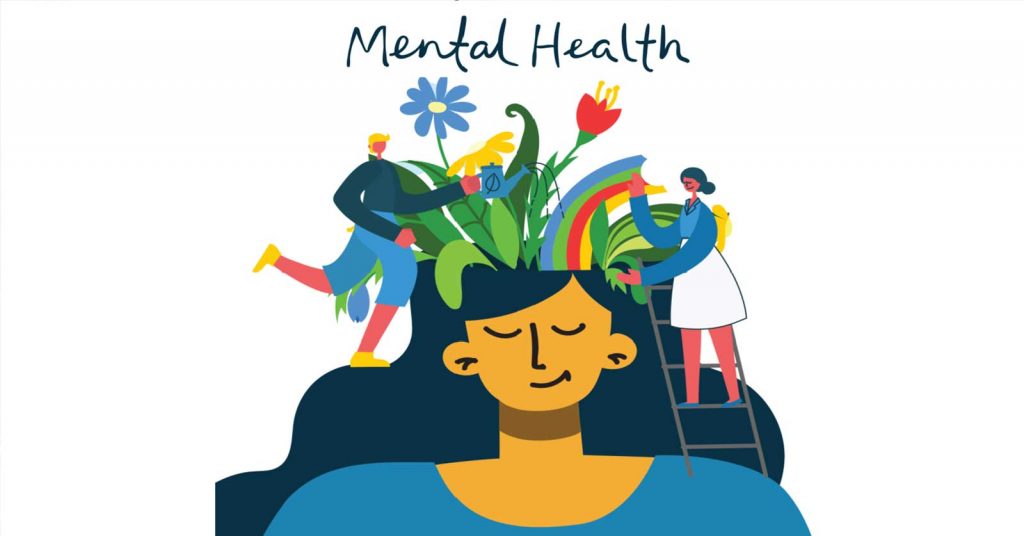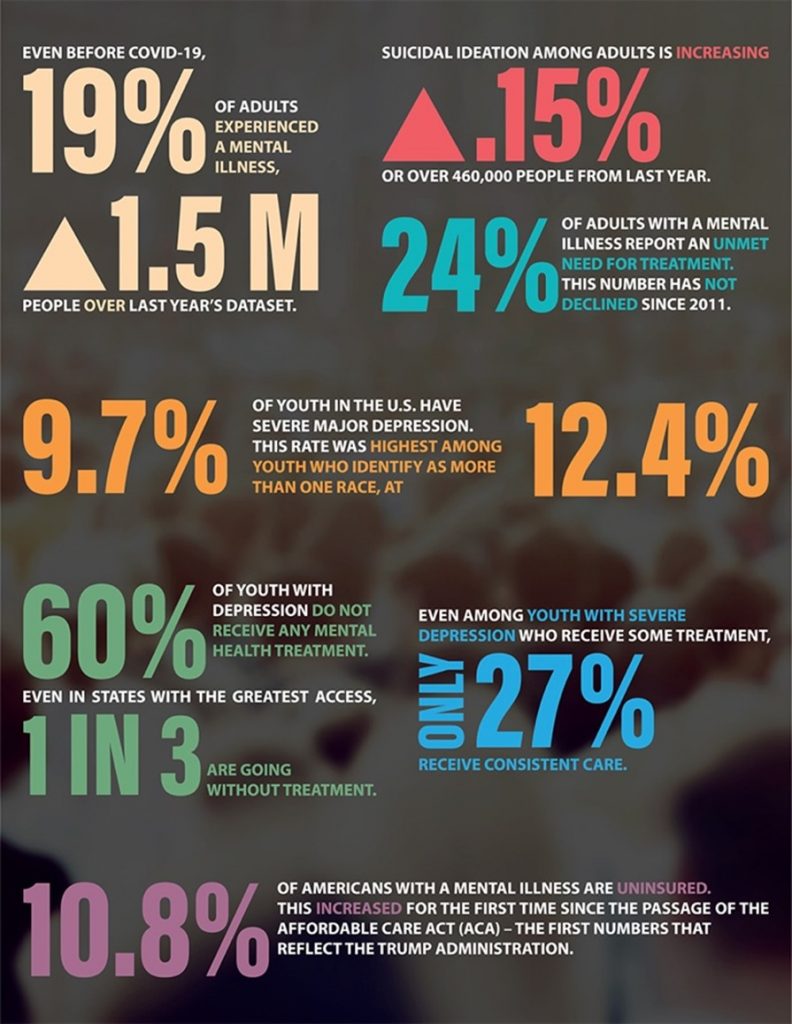
May is recognized as Mental Health Month to create awareness around mental health and break the stigma attached. Since 1949 it is observed each year in May. Today more than ever, it’s essential to understand that mental health is an integral component of overall health. The illnesses related to it are as common as illnesses in other body parts – they are familiar and treatable.
Heightened Awareness
The COVID-19 pandemic followed by the economic downfall has adversely affected people’s mental health for everyone. The lockdown last year added even more difficulty for patients already suffering from mental health issues and substance abuse disorders, preventing them from seeking medical help.
According to a recent report by the US Centers for Disease Control & Prevention (CDC), the percentage of adults with the most recent anxiety or depressive disorder symptoms increased sharply from 36.4 to 41.5%. The rate of people reporting unmet mental health care needs has increased from 9.2 to 11.7% between August 2020 and February 2021 due to the COVID-19 pandemic.
Though the general perception about mental illness has improved over time, it is still not enough to see it simply as an illness. The lack of education, awareness, and media stereotypes has resulted in people having wrong perceptions.

Infographic credit: Mental Health America
Awareness to Break the Stigma
While some may be more vulnerableto mental illness than others, it doesn’t change the growing statistics. Until last year, none of us knew that the coronavirus would disrupt our day-to-day lives, especially during the lockdown. Everyone experienced some kind of mental disturbance in the forms of worry, isolation, depression, loneliness, anxiety, etc.
In recognizing Mental Health Month, many hospitals and national health bodies have come together to support, educate and create awareness on mental health.
This year, the National Alliance on Mental Illness (NAMI) will continue to propagate its messaging, ‘You Are Not Alone.’ Through this initiative, NAMI will connect with people to encourage them to seek help, get appropriate support to live a healthy and fulfilling life. No one needs to be alone in their journey to recovery. The reach-out program includes NAMI’s blog, personal stories, videos, digital toolkits, social media engagements, and national events. (NAMI, 2021)
Mental Health America’s (MHA) theme is ‘Tools 2 Thrive’ and provides practical tools that anyone can use to work on their mental health and increase resilience despite their situation. The toolkit intends to create awareness on adapting after trauma and stress, taking time for yourself, getting out of thinking traps, dealing with anger and frustration, processing significant changes, and radical acceptance. (MHA 2021)
The American Hospital Association (AHA) also advocates for behavioral health issues, supporting the integration of behavioral and physical health. It aids hospitals in establishing partnerships to ensure access to a complete continuity of behavioral health care. (AHA 2021)
What is Mental Illness?
Mental illnesses, also known as mental health disorders, are health conditions that affect your mood, behavior, thinking, emotions, or a combination of any of these. Some of the illnesses include anxiety disorders, schizophrenia, depression, and addictive behaviors.
More often than we think, people can have mental health concerns. Still, if these illnesses are associated with distress and affecting your ability to function at home, work, or outside, it’s critical to seek medical help. These illnesses are common and have treatment.
Recent Statistics:
- Nearly one in five, or approximately 19 percent of U.S. adults, experience some form of mental illness
- One in 24, i.e., 4.1 percent, has a severe mental illness
- One in 12, which is 8.5 percent, has a diagnosable substance use disorder
(APA 2021)
Signs and Symptoms of Mental Illness
Depending on the disorder and the type of mental illness, the sign and symptoms can vary. If any of these symptoms affect your emotions, behavior, and thoughts often, it is best to follow up with a mental health professional.
- Change in appetite or sleep pattern – a noticeable change or decline in personal care, sleep, or appetite
- Having problems in thinking clearly – lack of concentration, memory loss, or lack of logical thought or speech that’s not easy to explain
- Increase in sensitivity – to smell, touch, sound, or sight
- Mood swings – drastic shifts in emotions, feeling low or constant depressed feelings
- Feeling disconnected – hitting a sense of delusion (unreal), paranoia, or a vague feeling of detachment from oneself, others, or surroundings
- Withdrawal symptoms – from friends, social circle and losing interest in meeting anyone
- Disrupted functioning – like a sudden loss of interest in performing day-to-day activities like school, work, sports, social activities, etc.
- Changes in physical intimacy like sex drives
- Illogical thinking like exaggerated beliefs about some ‘special’ powers or belief in imaginary life events.
- Nervousness, fear, or suspicion on others for no reason
- Unusual behavior like excessive anger, hostility, or acts of violence
- Problems with drug or alcohol abuse
- Suicide tendencies
(APA 2021)
In some cases, these behavioral changes may trigger physical problems such as back pain, headaches, stomach pains, or unexplained aches and pains in body parts. Remember, anyone or two of these symptoms are not conclusive of mental illness. These symptoms, however, may direct towards the need for further examination.
People showing suicidal tendencies or thoughts to harm themselves need immediate medical attention. Keep 911 handy, or contact the National Suicide Prevention Lifeline at 1-800-273-TALK (1-800-273-8255) or webchat on suicidepreventionlifeline.org/chat.
We Are Here to Help
Health care systems and hospitals play a vital role in providing treatment for behavioral/mental health issues. They have all the resources available to get the help you need.
If you experience mental illness symptoms that hinder your ability to function, consult a health professional. It’s a journey of self-realization, and healing. Remember, you are not alone!
Works Cited
MHA, Mental Health America. “Mental Health Month.” Mental Health America, 2021, www.mhanational.org/mental-health-month.
AHA, American Hospital Association. May Is Mental Health Awareness Month: Aha. 2021, www.aha.org/mental-health-awareness-month.
NAMI, National Alliance on Mental Illness. Mental Health Awareness Month. 2021, nami.org/Get-Involved/Awareness-Events/Mental-Health-Awareness-Month.
APA, The American Psychiatric Association. What Is Mental Illness?, 2021, www.psychiatry.org/patients-families/what-is-mental-illness.
APA, The American Psychiatric Association. Warning Signs of Mental Illness, 2021, www.psychiatry.org/patients-families/warning-signs-of-mental-illness.
